Search myodfw.com
The California kangaroo rat is the largest kangaroo rat in Oregon, but is only of moderate size within the genus. It has a moderately broad face, relatively large ears, and awl-shaped lower incisors. The tail is 150 percent of the length of the head and body. It is the darkest-colored kangaroo rat in Oregon. The pelage of the dorsum is composed of hairs with dark-gray bases, a narrow dark-buff band and black terminus. The venter, feet, upper lip,; and base, sides, and tip of tail are white and there is a white spot above each eye and behind each ear

The Chisel-toothed kangaroo rat is an intermediate-sized kangaroo rat with a narrow face, small ears, and flat-faced, nearly square-edged lower incisors shaped like miniature chisels. Among kangaroo rats, the cheek pouches in relation to the size of the head are exceptionally large. The pelage on the dorsum is composed of hairs with medium-gray bases, a buffy band, and a tiny blackish tip, overall a dirty-sand color. The venter, upper lip, feet, and base and sides of the tail are white and there is a white spot above each eye and behind each ear. A black moustache, eyelids, ears and tail

The Ord's kangaroo rat is a medium-sized kangaroo rat with awl-shaped lower incisors. It is the lightest-colored kangaroo rat in Oregon; overall the dorsum is a rich buff with gray overtones. The venter, upper lip, feet and side of the tail are white; there is a white spot above each eye and behind each ear; and a white stripe crosses each thigh. The moustache, eyelids, and ears are blackish. In Oregon, it occurs east of a line connecting The Dalles, Hood River County; Sisters, Deschutes County; and Lakeview, Lake County except in the Ochoco, Blue, and Wallowa mountains. Although occasionally
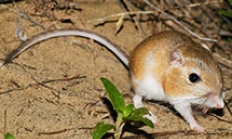
The Western harvest mouse is the smallest sigmodontine rodent in Oregon. It occurs east of the Cascade Range, except it is absent from the Blue and Wallowa mountains; it also occurs in the southern parts of Josephine and Jackson counties west of the Cascades. The Western harvest mouse commonly uses runways. It is active nocturnally with its greatest activity between sunset and sunrise. They spend periods of inactivity in ball-shaped nests constructed on the surface of the ground; nests are sometimes placed beneath shrubs or debris. Photo by J. N. Stuart, Flickr
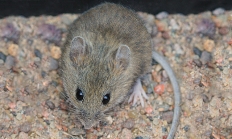
The canyon mouse is a moderate to small-sized mouse-like rodent with a long tail, nearly naked ears and a long, lax, and silky dusty gray pelage. In Oregon, most locations where the canyon mouse has been found are in Harney and Malheur counties, but the distribution includes a group of localities in Crook, Jefferson, Wasco, and Wheeler counties and another group in Lake County. There are also records of the species in extreme southeastern Baker County. Rock, primarily rimrock and talus slopes, seems to be the key component of habitats occupied by the canyon mouse. They are usually active nocturnally
The deer mouse is a moderately small mouse-like rodent that exhibits considerable variation in color, tail length and markings. In general, the pelage of adult deer mice is buff to dark brown on the dorsum and white on the venter. The ears are moderately long, essentially naked and usually held erect and directed forward. The eyes are black and beady. The deer mouse has the broadest distribution of any species within the genus and occurs throughout Oregon. Below the treeline, it occurs as part of essentially all communities. It is active nocturnally, the time of onset of activity is cued

The piñon mouse is the largest member of the genus in Oregon. It is characterized by its enormous ears. Hair color varies geographically; overall, in central and eastern Oregon it is a pale-buff color with a wash of black on the dorsum, whereas mice from southwestern Oregon are bright ocherous on the shoulders and flanks and a dirty brown on the dorsum. In Oregon, the piñon mouse has been found in Josephine, Jackson, Klamath, Lake, Deschutes, Jefferson, Grant, Crook, and Harney counties. East of the Cascade Range it is almost always associated with western juniper in rimrocks. In southwestern Oregon
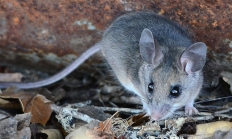
The Northern grasshopper mouse is a stockily built mouse with a thick tail. The dorsal pelage is dark sepia long the midline grading moderately sharply to a light tannish along the sides. The ventral pelage is white. A dark sepia line extends across the face between the eyes. The ears are thinly furred, sepia on the external surface and light grayish-tan on the internal surface. The feet and tip of the tail are white. In Oregon, Northern grasshopper mice have been found in grassland and desert areas in Crook, Deschutes, Gilliam, Harney, Jefferson, Klamath, Lake , Malheur, Morrow, Sherman, Umatilla
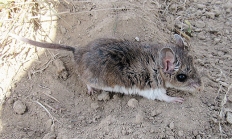
The bushy-tailed woodrat is a large rat-like mammal; its squirrel-like tail unique among members of the genus, is gray above and whitish below. The dorsum is buffy gray to dark brownish-black and the venter is white to buff depending on the geographic race. It occurs, statewide in a wide variety of habitats. It is active nocturnally. Sometimes, upon leaving the protection of its den, the woodrat may lie motionless on a rock or limb, watching for a long period before moving forth. Photo from ODFW

The dusky-footed woodrat is a medium-sized rat-like form with large, nearly naked ears, protruding eyes, and a long tail. The dorsal pelage consists of hairs with steel gray bases, a band of ocherous buff, and a tip of black. Hairs on the throat and belly are white. Although variably in extent, a dusky splotch occurs on the dorsal surface of the white feet. In Oregon, this woodrat occurs from the California border northward along the coast to near Bandon, northward inland through the Willamette Valley and other interior valleys to near Mollala and Monmouth, and northward to Brownsboro, Jackson County
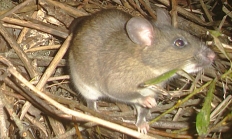
The desert woodrat is the smallest member of the genus that occurs in Oregon. The tail is round, short and bicolored and the ears are long and lightly furred. The pelage is long and soft, a mixture of buff and black dorsally and whitish or light buff ventrally; except for he chest, all body hairs have lead-colored bases. The feet and underside of the tail are white. It occurs in Malheur, Harney, and southern Lake Counties. Throughout its range, it tends to be a habitat generalist, but in Oregon it usually occurs in sagebrush habitats, especially those associated with rimrocks
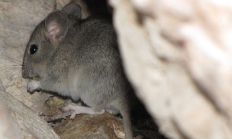
The Norway rat is the largest member of the subfamily in Oregon. This heavy-bodied rat has a scantily haired, scaly tail shorter than the length of the head and body. The ears are membranous and lightly furred. The pelage is course, a grizzled brownish or rusty gray dorsally and dirty white to yellowish gray ventrally. Albino, melanistic, and spotted specimens are known to occur in free-living populations. This rat is distributed throughout the world in association with humans and in Oregon is found in most of the counties west of the Cascade Range and from some counties along the Columbia
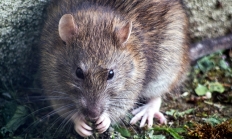
The black rat is slightly smaller than the Norway rat, but much larger than the house mouse, the only other members of the subfamily in Oregon. The black rat is similar to other members of the subfamily in that it possesses a scaly, scantily haired tail; membranous, nearly naked ears, and a soft pelage. It differs from the Norway rat in having a tail much longer than the length of its head and body and commonly having a darker-colored pelage. The pelage ranges from black to sandy brown dorsally and from lead colored to nearly white ventrally. The black rat

The house mouse is the smallest member of the subfamily in Oregon and smaller that most other members of the family. The ears are large and membranous; the tail is long, tapering, and scaly; and the soles of the feet are naked. The pelage is short, harsh, and usually grayish brown to nearly black dorsally, lighter brown or buffy ventrally. Albino, spotted, and other colormorphs are known to occur. House mice occur throughout the world in association with humans. In Oregon, this mouse is found in 30 of the 36 counties. House mice are usually more active at night, but
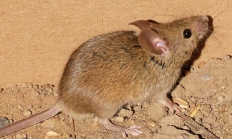
The Western red-backed vole is among the smaller of the voles in Oregon. The pelage consists of a vaguely demarked reddish-brown or chestnut-brown stripe on the dorsum grading to buffy gray to dark gray on the sides and venter; the tail is indistinctly bi-colored, light grayish-brown above and whitish below. This vole occurs from the Columbia River south through the Coast Range. It does not occur in the Willamette Valley or other interior valleys west of the Cascade Mountains. It is a denizen of forest habitats, but tends to be most abundant in closed canopy old-growth forests containing an abundance

The Southern red-backed vole is among the smaller voles in Oregon. The pelage is silvery on the venter and grayish with ocherous on the sides, and with a rusty or reddish stripe on the dorsum; the tail is dark brown or black above and whitish or grayish below. In Oregon it occurs in the Ochoco, Blue, and Wallowa Mountains southwestward to central Crook County and northern Harney County. Photo by D. Gordon Robertson, Wikipedia
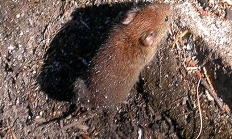
The white-footed vole is among the smaller voles. The pelage consists of dark bluish-gray hairs tipped with a rich brown or black on the dorsum grading lighter on the sides, thence to light gray to pinkish buff on the venter. The tail is distinctly bi-colored: white or buff on the vental surface, brownish black on the dorsal surface. The dark dorsal stripe is much wider than the lighter ventral stripe. The feet are light grayish. This vole occurs from Old Fort Clatsop, Clatsop county, and near Rainier, Columbia County, south through the coast range. Various Oregon specimens have been found
The heather vole is among the smaller voles in Oregon. In appearance, it strongly resembles the montane vole. It is gray to brownish on the dorsum, whitish to grayish on the venter. Two of nine nominal subspecies are purported to occur in Oregon: the lighter colored P. I. intermedius in the Blue and Wallowa mountains of northeastern Oregon and the darker P. I. oramontis in the Cascade Range. Heather voles are rather docile creatures; they usually make little attempt to flee or to defend themselves when captured. It is active during daylight hours more frequently than the Southern red-backed vole
The red tree vole is a medium-sized vole. It is uniquely colored among North American voles: bright orangish-red to cinnamon on the dorsum, silvery gray (often with some light orangish hairs) on the venter, and a tail pale orangish on the venter grading to black on the dorsum. This vole is endemic to western Oregon. It occurs at moderate elevations on the west slope of the Cascade Range southward as far as the Douglas-Jackson county line and in the Coast Range to the Oregon-California border. It is largely arboreal and builds nests on suitable foundations (commonly nests of birds or

The California vole is a medium-sized vole with a cinnamon-brown to tawny-olive dorsum overlain by dark brown or black hairs. The underparts are medium gray, sometimes washed with buff; the tail is bi-colored, black above and gray below. The feet are grayish. It occurs from near Eugene south through the interior valleys of Oregon and most of California. It has been found in the drainages of the upper Willamette, Umpqua, and Rogue rivers in Lane, Douglas, Jackson, and Josephine counties. This vole spend most of the time underground in its burrows or in those of other species; it makes only

